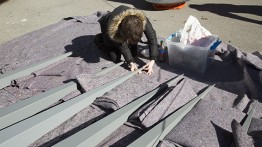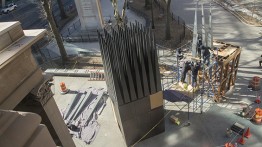Hejduk-Designed Memorial Built in Cooper Park
POSTED ON: March 29, 2017
A set of 24-foot structures designed by John Hejduk, dean of The Irwin S. Chanin School of Architecture from 1975 to 2000, have been built in the plaza south of the Foundation Building by a team led by Steven Hillyer, director of the architecture archives. The structures, which will remain in Peter Cooper Park until June 11, are being presented in conjunction with an exhibition of photographs by Hélène Binet of Hejduk’s permanent and temporary-built works, including the Berlin Tower, the cubist-inspired Wall House II, and most recently, the Jan Palach Memorial, unveiled in January, 2016 in Prague, Czech Republic. [See the NY1 spot.]
The structures at Cooper are another iteration of that same memorial and were first constructed at the Georgia Institute of Technology (Georgia Tech) in Atlanta in 1990, and separately on the grounds of Prague Castle in 1991. The memorial – one of Hejduk’s most political works – honors the Czech dissident Jan Palach whose self-immolation in protest of the Soviet invasion of Czechoslovakia in 1968 served as a galvanizing force against the communist government in power at the time. Comprised of two structures – House of the Suicide and House of the Mother of the Suicide – the work was reassembled in front of The Cooper Union’s Foundation Building from the original materials fabricated by Georgia Tech students in 1990.
Mr. Hillyer noted that in addition to the entire Buildings & Grounds crew helping to unload trucks filled with materials, 46 people participated in the construction, which took approximately two weeks to complete. One of the most challenging parts of the process was lifting each of the 98 spikes, which weight about 100 pounds each. They required seven people to lift them into place. Speaking about the building process, Mr. Hillyer said, “I think we learned about the intimacy and collaborative nature of a human scale building effort. We didn’t have machinery other than small scale power tools, and there were no lifts or powered hoists to move elements into place. It was human interaction and communication at its best. Everyone found their role and worked together to achieve whatever was next.”
A 1950 graduate of The Cooper Union, Hejduk significantly transformed architecture education through his role as dean here. Mr. Hillyer, a 1990 graduate of the School of Architecture, commented upon his 10 years working with with Dean Hejduk. “It was a remarkable time, and the work took place both here and abroad. John was one of the most prolific creative individuals I have ever encountered. Being able to honor him, and his work, in this way has filled me with a great sense of gratitude.”







